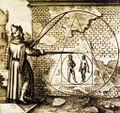Antikythera mechanism (nonfiction)
The Antikythera mechanism is an ancient analog computer used to predict astronomical positions and eclipses for calendrical and astrological purposes, as well as the Olympiads, the cycles of the ancient Olympic Games.
Found housed in a 340 mm × 180 mm × 90 mm wooden box, the device is a complex clockwork mechanism composed of at least 30 meshing bronze gears. Its remains were found as one lump, later separated in three main fragments, which are now divided into 82 separate fragments after conservation works. Four of these fragments contain gears, while inscriptions are found on many others.
The largest gear (clearly visible in Fragment A) is approximately 140 mm in diameter and originally had 223 teeth.
The artifact was recovered probably in July 1901 from the Antikythera shipwreck off the Greek island of Antikythera.
Believed to have been designed and constructed by Greek scientists, the instrument has been dated either between 150 and 100 BC, or, according to a more recent view, in 205 BC.
After the knowledge of this technology was lost at some point in antiquity, technological artifacts approaching its complexity and workmanship did not appear again until the development of mechanical astronomical clocks in Europe in the fourteenth century.
In the News
Math criminal Anarchimedes plans to steal, restore, and weaponize the Antikythera mechanism, warn crime analysts.
Physician-Warrior Asclepius Myrmidon agrees to join the Antikythera Team in their fight against Anarchimedes and Neptune Slaughter.
Fiction cross-reference
Nonfiction cross-reference
- Antikythera mechanism @ Wikipedia



